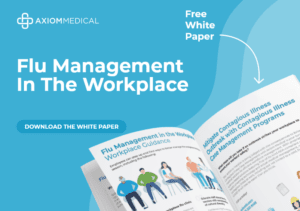As the year wraps up, many organizations enter their busiest and most unpredictable season. Year-end deadlines and increased absences reliably make the holiday period one of the most challenging times for HR and Safety Leaders to maintain consistent workplace safety.
Our year-end guide highlights practical, end-of-year strategies—focused on real-world risks that tend to spike in November and December—and offers clear steps you can put in place right now to keep your workforce safe, productive, and confident heading into the new year.
Quick Year-End Workplace Safety Checklist
Before the holiday rush:
- Revisit seasonal hazards and operational risks
- Send brief, timely safety reminders
- Update training, especially for seasonal or reassigned workers
- Evaluate winter-weather exposures, facility layout changes, and temporary décor
- Review staffing patterns for fatigue risks
- Reinforce reporting expectations and open communication
1. Understand the Holiday Season’s Unique Risk Factors
Year-end workloads often lead to patterns that HR and Safety Leaders should watch closely:
- Fatigue and distraction
Employees may cover shifts, work longer hours, or simply feel holiday stress. Reduced focus is one of the biggest contributors to errors.
- Increased operational pressure
When teams rush to complete year-end goals, safety procedures can take a back seat—sometimes unintentionally.
- Environmental and facility changes
Décor, events, deliveries, winter weather, and rearranged layouts can introduce new hazards that don’t exist the rest of the year.
- Seasonal or temporary workers
These team members may have less training or familiarity with your safety culture, which raises injury risk without proper onboarding.
Understanding these patterns helps leaders pinpoint where intervention matters most.
2. Communicate Before Risks Peak
One of the most effective tools for preventing incidents is consistent, proactive communication.
Best practices:
- Share short, specific reminders about timely topics—slips, lifting, ladder use, equipment checks, PPE expectations, etc.
- Use multiple formats: shift briefings, email, SMS, posters, and digital signage.
- Better safe than sorry: make messages proactive, not reactive.
- Reassure employees that reporting concerns early is expected and valued.
Clear communication reduces guesswork and creates alignment before the season gets hectic.
3. Provide Targeted Refreshers That Match Year-End Hazards
Even experienced employees benefit from short, focused refreshers during high-pressure weeks.
Helpful topics include:
- Safe material handling
- Prevention of slips, trips, and falls
- Holiday-specific electrical and extension cord safety
- Weather-related precautions
- Emergency procedures and first-aid awareness
And for seasonal workers:
- Provide a structured (but efficient) orientation
- Confirm understanding of daily expectations
- Offer more check-ins during early shifts
- Make it clear who they can go to for help or clarification
Small training moments can prevent big disruptions during busy weeks.
4. Review Your Physical Space with a Seasonal Lens
Decorations, rearranged workspaces, deliveries, and events can make even well-managed facilities more unpredictable.
A year-end walkthrough should include:
- Ensuring walkways are clear
- Checking electrical loads and temporary power setups
- Confirming exits and emergency equipment aren’t blocked
- Addressing winter-weather entry hazards (ice, wet floors, reduced visibility)
- Reviewing storage areas that might accumulate seasonal materials or overflow inventory
A simple walk-through often reveals risks that are quick to fix.
5. Prioritize Employee Well-Being to Reduce Human-Factor Risks
The holiday season can bring financial pressures, personal commitments, and end-of-year fatigue. These factors directly influence safety behavior.
Consider strengthening:
- Schedule flexibility when possible
- Peer recognition and morale-boosting moments
- Awareness of wellness or EAP resources
- Transparency around priorities and workload expectations
Caring for people holistically reduces preventable mistakes.
6. Use End-of-Year Data to Make Better Decisions
This is a powerful time to review trends from the past year:
- Incident and near-miss patterns
- Departments with increased seasonal exposure
- Training gaps that appear during busy periods
- Equipment issues that correlate with certain tasks
- Time-of-day or staffing patterns connected to incidents
These insights help leaders refine holiday safety practices and set stronger strategies for Q1.
7. Close the Year with a Safety-First Foundation for January
Once peak season stabilizes, use the momentum to prepare for a strong start to the new year:
- Refresh or revise safety policies
- Schedule January training or toolbox talks
- Plan equipment inspections or maintenance
- Re-align safety committees
- Celebrate teams or individuals who supported year-end safety efforts
A safe finish sets the tone for a productive and safe year ahead.
Continue Learning: Join Our Holiday Safety Webinar
To dive deeper into seasonal safety, join us for Seasonal Safety Success: Ensuring a Joyous and Safe Holiday Season, hosted by Nurse Holly Foxworth and featuring Chief Medical Officer Dr. Scott Cherry, Chief Marketing Officer Dara Wheeler, and special guest Hailey Hamilton, EHS Program Manager at Juniper Landscaping, who will share firsthand knowledge about what it takes to keep crews safe during peak season.










